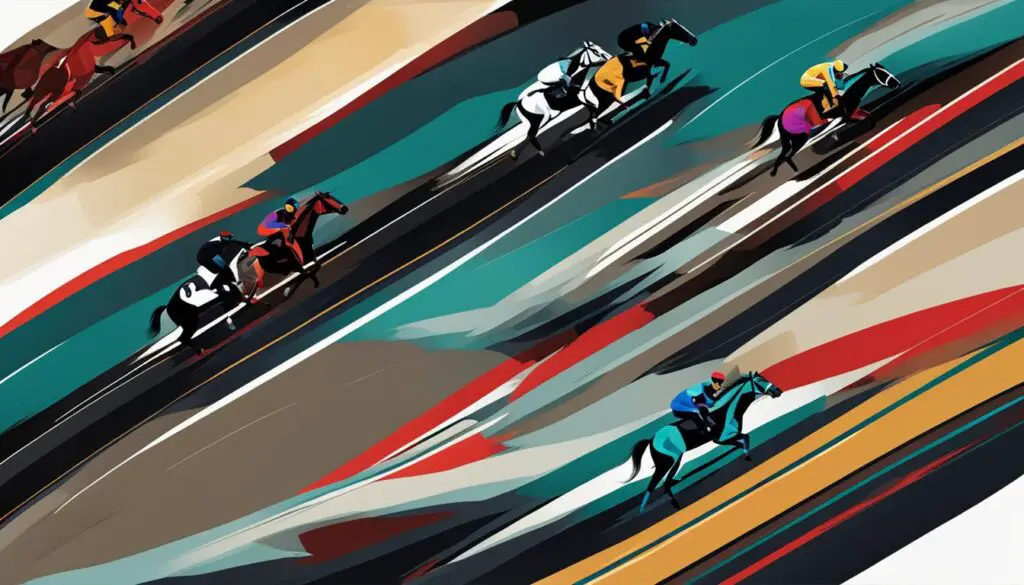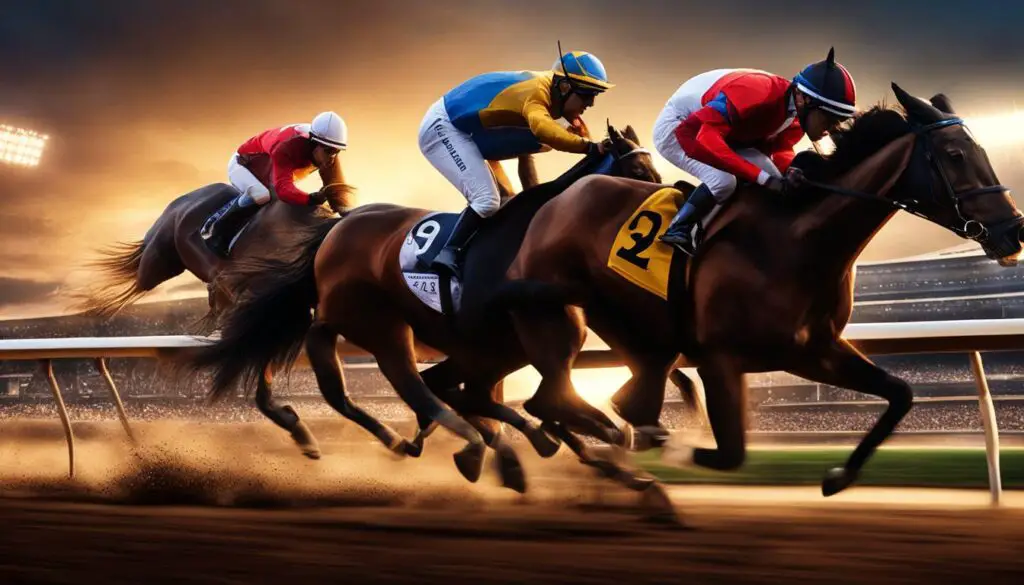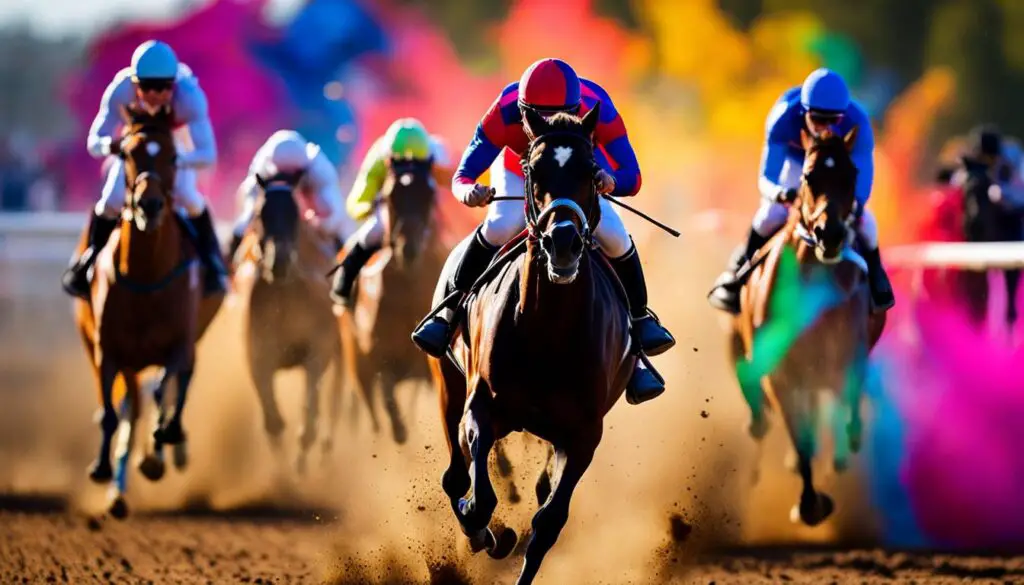Welcome to our exploration of the fascinating world of horse racing! Have you ever wondered just how long these thrilling races actually last? In this article, we will delve into the varying durations of horse races and the factors that influence them. Whether you’re a racing enthusiast or a curious newcomer, join us as we uncover the secrets behind race length and the excitement it brings to this beloved sport.
Key Takeaways:
- Horse races can vary in duration, ranging from a few furlongs to several miles.
- The length of a race depends on factors such as track conditions, horse speed, and any obstacles or jumps in the race.
- Thoroughbred races typically fall between 5 and 12 furlongs, with the most common races being around 1 mile in length.
- Different horse breeds excel in different types of racing, impacting the duration of the races they compete in.
- Calculating the exact duration of a horse race can be challenging, as it depends on various factors and unexpected circumstances.
Factors Affecting Horse Race Length
The length of a horse race can be influenced by several factors that contribute to the overall duration of the race. These factors include track conditions, race distance, and the speed and endurance of the horses.
“Track conditions play a significant role in determining race length,” explains racing expert Jane Smith. “A wet or muddy track can slow down the horses and result in longer race times, while a firm and dry track can facilitate faster speeds.”
The distance of the race also affects its length. Generally, longer races take more time to complete compared to shorter races. For example, a 1-mile race may take around 1 minute and 40 seconds to finish, while a 1.5-mile race could take closer to 2 minutes and 30 seconds.
The speed and endurance of the horses themselves are crucial factors in determining race length. Horses that can maintain a consistent pace throughout the race are likely to have shorter overall race times, while those that struggle to maintain speed may have longer race durations.
Key Factors Affecting Horse Race Length:
- Track conditions, such as wet or dry surfaces
- Race distance
- The speed and endurance of the horses
“Understanding these factors is essential for bettors and enthusiasts alike,” says Smith. “By considering these variables, one can better analyze race times and make more accurate predictions about potential outcomes.”
Race Length in Thoroughbred Racing
In thoroughbred racing, the length of the race is a crucial factor that determines the level of excitement and showcases the speed and endurance of these magnificent horses. Thoroughbred races typically have a standard race distance falling between 5 and 12 furlongs, with the most common races being around 1 mile in length. These shorter distances allow for faster-paced races, where horses demonstrate their explosive speed and agility.
However, there are also longer races in thoroughbred racing that put the horses’ stamina to the test. The Kentucky Derby, one of the most prestigious races in the world, is run at a distance of 1 1/4 miles, while the Belmont Stakes, the final leg of the Triple Crown, challenges horses with a grueling 1 1/2-mile track. These longer distances separate the elite performers who can maintain their speed over a prolonged period, making for thrilling battles for the finish line.
Thoroughbred racing offers a captivating range of race lengths, each presenting a unique challenge for the horses and jockeys. From the quick and exhilarating sprints to the ultimate tests of endurance, these races captivate spectators and bettors alike with their unpredictable outcomes and adrenaline-pumping moments.

Standard Racing Time for Horses
While there is no fixed standard racing time for horses in thoroughbred racing, each race length has its own average duration based on historical data and the performance of previous races. These standard race times serve as reference points for analyzing race performances and assessing the capabilities of horses in different race distances.
It’s important to note that the actual race duration can be influenced by various factors, such as track conditions, the speed of the horses, and the presence of any obstacles or jumps. Each race is unique, and unforeseen circumstances can impact the outcome and duration of the race, adding to the excitement and unpredictability of thoroughbred racing.
Overall, race length plays a crucial role in shaping the dynamics and thrill of thoroughbred racing. Whether it’s a short burst of speed or a battle of endurance, these races test the physical abilities and strategic prowess of both horses and jockeys, making every race a spectacle to behold.
Race Duration of Different Horse Breeds
When it comes to horse racing, different horse breeds excel in various types of races, and this can significantly impact the duration of the races themselves. Each breed possesses its own unique attributes and abilities that make them well-suited for specific race distances and conditions.
Thoroughbreds, renowned for their speed and agility, typically compete in shorter and faster races, where they can showcase their exceptional athleticism. This breed is known for its ability to sustain high speeds over short distances, making them ideally suited for sprint races.
Thoroughbreds are the racehorses of choice for shorter races, where their speed and agility shine. Their ability to maintain high speeds over shorter distances makes them perfect for sprint races.
On the other hand, breeds such as quarter horses are known for their explosive acceleration and short bursts of speed. These horses are often seen in races that require quick bursts of energy, such as quarter-mile sprints. Their races are typically shorter in duration but no less thrilling.
For endurance races, which demand a steady and consistent pace over long distances, breeds like Arabians are often favored. These horses possess excellent stamina and the ability to maintain a consistent speed for extended periods, making them well-suited for races that span several miles.
The duration of a horse race is influenced by the breed’s physical attributes and racing abilities:
- Thoroughbreds: Suited for shorter races, showcasing their speed and agility.
- Quarter Horses: Excel in sprint races, known for their explosive acceleration and short bursts of speed.
- Arabians: Favored for endurance races, possessing excellent stamina and the ability to maintain a consistent pace over long distances.
Understanding the different strengths and capabilities of each horse breed adds to the excitement and intrigue of watching and betting on horse races. Whether it’s the lightning-fast sprints of thoroughbreds, the explosive bursts of quarter horses, or the impressive endurance of Arabians, each breed brings its own unique flavor to the world of horse racing.
Calculating Horse Race Duration
Estimating the duration of a horse race can be a complex task that involves considering various factors. While it is possible to calculate an approximate time by dividing the race distance by the average speed of the horses, this method does not take into account critical elements such as track conditions, horse performance, and any obstacles in the race. It is important to keep in mind that unexpected circumstances like accidents or delays can also impact the actual duration of a horse race.

Despite the challenges, calculating race duration holds significance in horse racing. By analyzing race times, bettors and racing enthusiasts gain insights into the speed and performance of horses. Race durations provide valuable information for predicting future outcomes and identifying potential winners. However, it is essential to remember that race times are influenced by various factors, and relying solely on calculated times may not provide a complete picture of a horse’s capabilities.
Ultimately, the duration of a horse race is an integral part of the sport’s allure. Whether it’s a quick sprint or a grueling endurance race, the varying lengths create anticipation, excitement, and suspense for bettors and spectators alike. The challenge of accurately predicting race times and outcomes adds an element of strategy and intrigue to horse race betting, making it a thrilling pastime for millions of racing enthusiasts around the world.
The Thrill of Horse Race Length
Horse racing is not just about the competition between horses and jockeys; it’s also about the excitement and thrill that comes with the duration of the race. Whether it’s a quick sprint or a test of endurance over a longer distance, the varying race lengths create anticipation and suspense for both bettors and spectators.
Shorter races, such as sprints, are known for their intense bursts of speed. These races can be over in a matter of seconds, with horses pushing their limits to cross the finish line first. The adrenaline rush of watching these lightning-fast races keeps spectators on the edge of their seats.
On the other hand, longer races showcase the horse’s stamina and ability to maintain a consistent pace. These endurance tests can last for several minutes or even hours, with horses and jockeys battling it out until the very end. The longer the race, the more strategies and tactics come into play, making every moment captivating.
Quote: “The duration of a horse race adds to the excitement and thrill of the sport. Whether it’s a quick sprint or a test of endurance over a longer distance, the varying race lengths create anticipation and suspense for bettors and spectators.”
As a spectator, part of the excitement lies in trying to predict the outcome based on the race length. Will the speed demons dominate the shorter races, or will the relentless stayers prevail in the longer ones? The challenge of accurately predicting race times and outcomes adds an element of strategy and skill to horse race betting, making it a favorite pastime for many.
The Allure of Diverse Race Lengths
The fascination with race length in horse racing is not only about the thrill but also the opportunity to witness the versatility of these magnificent animals. From quick sprints to endurance tests, each race length offers a unique challenge for horses and jockeys to showcase their abilities.
- Shorter races highlight speed, agility, and the explosive power of horses.
- Mid-length races test both speed and endurance, requiring horses to maintain their pace for an extended period.
- Longer races demand exceptional stamina, strategy, and the ability to conserve energy for a strong finish.
Every race length has its own allure, attracting fans with different preferences and interests. Some enjoy the heart-pounding excitement of short sprints, while others appreciate the strategic battles unfolding in longer races. The diversity of race lengths in horse racing ensures that there is something for everyone, making it a beloved sport enjoyed by millions worldwide.
Standard Racing Time for Horses
While there is no fixed standard racing time for horses, the duration of races can be influenced by various factors such as breed, class, and distance. Each type of race may have its own standard race time based on historical data and average race speeds. These standard times serve as a reference point for analyzing race performances and predicting future outcomes.
Calculating the exact duration of a horse race can be challenging, as it depends on multiple variables. One method to estimate the duration is to consider the average speed of the horses. By dividing the race distance by the average speed, an approximate time can be calculated. However, it is important to note that this method does not take into account factors such as track conditions, horse performance, or any obstacles in the race.
It is essential for bettors and horse racing enthusiasts to consider these standard race times along with other factors that can impact actual race durations. Unexpected circumstances, such as accidents or delays, can significantly affect the duration of a horse race. Therefore, it is crucial to analyze race data, track conditions, and horse performance to make informed decisions when betting or evaluating the potential outcomes of a race.
The Intrigue of Horse Racing Time
The concept of horse racing time adds an element of intrigue to the sport. Bettors and racing enthusiasts analyze race times to determine the speed and performance of horses, as well as potential improvements or declines in their form. Comparing race times across different tracks and conditions allows for a deeper understanding of a horse’s capabilities. Additionally, race times can reveal trends and patterns, such as certain distances or race types where a horse consistently performs well. This information is invaluable when making informed betting decisions and identifying potential winners.

“Race times can often be deceiving,” says racing expert Jane Miller. “It’s not just about who finishes first, but how they achieved that victory. Factors such as track conditions, jockey tactics, and even the weight carried by the horse can significantly influence race times. It’s important to consider the whole picture and not rely solely on the numbers.”
Understanding the significance of race times requires a comprehensive analysis that goes beyond the mere numbers displayed on the scoreboard. Experienced bettors and racing enthusiasts delve into the intricate details of each race, taking into account the horse’s previous performances, the class of competition they faced, and any visible improvements or setbacks in their overall performance. By doing so, they can gain a better understanding of a horse’s true potential and make more informed decisions when it comes to betting.
Uncovering the Secrets of Horse Racing Time
- Track Conditions: Different track surfaces, such as dirt, turf, or synthetic, can greatly influence race times. Some surfaces may be faster or slower, depending on weather conditions and maintenance.
- Jockey Tactics: The strategy employed by the jockey can have a significant impact on race times. Skillful jockeys know when to conserve energy, when to make a move, and how to position their horse for optimal speed and acceleration.
- Weight Carried: The weight carried by a horse, including the jockey and any additional equipment, can affect their performance and race time. Heavier weights may slow down a horse, while lighter weights can enhance their speed.
- Track Configuration: The layout and configuration of a racecourse can also influence race times. Some tracks have longer straightaways, while others may have tighter turns, requiring horses to adjust their stride and maintain their speed.
By considering these factors and conducting a thorough analysis, bettors and racing enthusiasts can gain a deeper understanding of horse racing time and use this knowledge to their advantage. It’s an art that combines data analysis, intuition, and experience to make informed decisions and enjoy the thrill and excitement of horse racing.
The Fascination of Race Length in Horse Racing
The duration of horse races and the varying lengths at which they are run add to the fascination and allure of horse racing. From quick sprints to endurance tests, each race length offers a unique challenge for horses and jockeys.
The unpredictability of race outcomes, influenced by factors such as form, breeding, and track conditions, keeps bettors and spectators engaged. Whether it’s the excitement of a fast-paced sprint or the tension of a prolonged battle for the finish line, race length contributes to the captivating nature of horse racing, making it a beloved sport enjoyed by millions worldwide.
Understanding the average length of horse races and the concept of horse racing time allows enthusiasts to appreciate the intricacies of the sport. It adds an extra layer of strategy and excitement when analyzing race performances and identifying potential winners. The ability of horses and jockeys to adapt their strategies and pace themselves accordingly adds to the thrill of each race.
FAQ
How long are horse races?
Horse races can vary in duration depending on several factors, ranging from a few furlongs to several miles.
What factors affect horse race length?
The length of a horse race can be influenced by track conditions, the speed of the horses, and any obstacles or jumps they need to navigate.
What is the race length in thoroughbred racing?
In thoroughbred racing, the standard race distance typically falls between 5 and 12 furlongs, with the most common races being around 1 mile in length.
How does the horse breed impact race duration?
Different horse breeds excel in different types of racing, which can impact the duration of races. Thoroughbreds typically compete in shorter races, while breeds like Arabians are favored for endurance races.
How can horse race duration be calculated?
One way to estimate the duration of a horse race is by considering the average speed of the horses and dividing the race distance by that speed. However, this method doesn’t account for other factors like track conditions or obstacles.
What is the thrill of horse race length?
The varying race lengths in horse racing add excitement and anticipation for bettors and spectators, with shorter races showcasing speed and longer races testing endurance.
Is there a standard racing time for horses?
While there is no fixed standard racing time for horses, each type of race may have its own standard race time based on historical data and average race speeds.
What is the intrigue of horse racing time?
Horse racing time adds an element of intrigue to the sport, allowing bettors and racing enthusiasts to analyze race performances and predict outcomes based on race times.
What is the fascination of race length in horse racing?
The varying lengths of horse races contribute to the fascination and allure of the sport, offering different challenges for horses and jockeys and keeping bettors and spectators engaged.
Source Links
- https://www.espn.in/horse-racing/story/_/id/10275078/unraveling-2014-horse-racing-mystery
- https://www.latimes.com/sports/more/la-sp-horse-racing-newsletter-20171203-htmlstory.html
- https://www.sheebamagazine.com/articles/business-education/longshot-horse-racing-bets-unraveling-the-mystery-and-maximizing-your-winnings/
